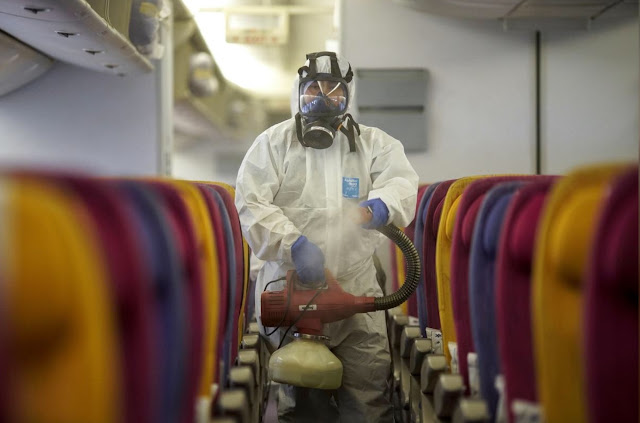Coronavirus: air transport paralysed
The coronovirus epidemic is spreading and has become global. An infected person would infect between 1.5 and 2.5 people on average. The Chinese authorities have therefore decided to quarantine the town of Wuhan, where the epidemic began. One of the world's largest airports is thus paralysed and the consequences on air transport are considerable.
 |
| In Bangkok International Airport, an employee of Thaï Airways desinfects the cabin of an aircraft to prevent the coronavirus to spread(credits:Reuters) |
Preventive measures put in place
As early as January 17, the United States decided to control the temperature of passengers arriving from Wuhan.All transport was interrupted in Wuhan, where the virus started, from 10 am on 23 January 2020. Trains, buses, planes, ferries,... are concerned. The airport is still open with several hundred cancelled flights. Only a few planes are allowed to land. China Southern has decided to stop all flights to Wuhan.
 |
| Wuhan airport under scrutiny (credits:chinapress online) |
The opening of China as a transmission factor...
With China's economic growth, Chinese air transport is expanding rapidly. As far as domestic flights are concerned, air transport is expected to grow by 10% in 2018. Today, China accounts for a quarter of the world's commercial aircraft fleet.A slowdown in air transport
The coronavirus appears to represent the greatest epidemic threat to global air travel since the SARS outbreak, which at its peak in April 2003 led to a 45 percent drop in passenger demand in Asia, according to analysts."There are currently no World Health Organization (WHO) recommendations to restrict travel or trade," said Iata Director General Alexandre de Juniac, quoted in the statement. "But it is clear that there is a drop in demand on routes associated with China, and airlines are responding by cutting capacity," he adds, citing "significant adjustments to flight schedules for February.
 |
| Passengers inspected on a Scoot flight in January 2020 (credits:weibo) |
WHO advise passengers during the epidemic.
An airport of international stature
The main terminal has a capacity of 35 million passengers. Opened in 2017, it replaces the two old terminals. The airport has two runways. Every day, more than 600 flights are scheduled.Wuhan Tianhe Airport handled nearly 25 million passengers in 2018, making it the busiest airport in Central China (16th in terms of traffic in China). In comparison this is as much as the Australian population in the same year.
 |
| Wuhan Tianhe airport seen in January 2020 (credits: Bloomberg) |
In addition to various domestic and continental connections, the airport offers intercontinental flights to San Francisco, New York JFK, Sydney, Paris, London, Rome, Istanbul and Moscow.
On 25 January, rescue teams arrived at Wuhan Airport to assist the city's hospitals. These hospitals are under-capacitated.
Security measures are being put in place throughout China, such as here at Shenyang Taoxian airport. Airlines have reduced or even cancelled their flights to Wuhan. Many airlines have announced that they are discontinuing their services, such as Air France, Air Asia and Malindo Air.
Flight interruptions
Major airlines serving China have suspended their flights. On 30 January 2020, Air France temporarily suspended its flights to Beijing and Shanghai. Air Mauritius, Air Madagascar, Air India, SAS Scandinavian Airlines and Turkish Airlines have also decided to suspend their flights.On 26 January 2020, the death toll stood at 56 and more than 1,000 people were infected. On 15 February, the death toll stood at 1527 dead and 67,178 contaminated.



Comments
Post a Comment